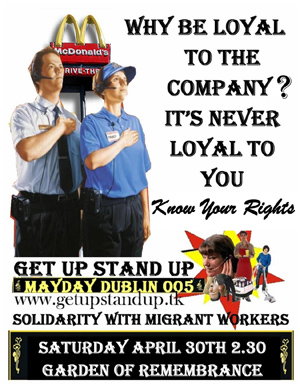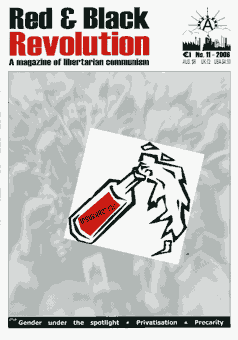Over 30 years of anarchist writing from Ireland listed under hundreds of topics
Precarity: An Introduction to a Word
 Precarity is a term synonymous with precariousness. It is perhaps best conceived as chronic insecurity. In recent times with the dismantling of the welfare state, the destruction of social security, workers’ existence is becoming more and more insecure. Precarity is a term that has been developed to describe these changes and the new form of working class existence that has developed due to them.
Precarity is a term synonymous with precariousness. It is perhaps best conceived as chronic insecurity. In recent times with the dismantling of the welfare state, the destruction of social security, workers’ existence is becoming more and more insecure. Precarity is a term that has been developed to describe these changes and the new form of working class existence that has developed due to them.
The term is used in particular to refer to the demise of the job-for-life and job security. In this sense it is closely linked to the process of casualisation. For anti-capitalists the significance of these changes has been quite large. The social-democratic/mass trade union model of working class action does not seem fit to deal with this new situation. The level of union membership in the working class is continuously on the decrease. This decrease in union membership is, unfortunately, not being replaced with any new form of workplace organisation.
The difficulties posed by organising precarious workers have led the trade union movement to, for the most part, abandon these workers. Precarious workers, those who are most in need of protection and organisation are today the least organised.
As many anti-capitalist activists are precarious workers, the issue of precarity is one that has been widely debated within the international anti-capitalist movement.
Some hold that it is a completely new phenomenon, while other hold that it is a return to what existed before the exceptional period of Keynesian capitalism, or social-democracy. Still others question whether the ‘job for life’ ever existed for the mass of society. (For a detailed look at work in the 21st Century see ‘The Nomad, the Displaced and the Settler: Work in the 21st Century’ in Red & Black Revolution 9.
Part of the whole debate about precarity is driven by those who once identified industrial workers as the vanguard of revolutionary change, and who now see precarious workers as fulfilling this role. While this may not be a particularly useful analysis, we should not ignore the question of how to organise these workers.
Here we offer a few samples of what is happening around this issue of precarity. We open with an article by James Redmond on some attempts by Irish libertarians to engage with this issue. He discusses the ‘Get Up, Stand Up’ campaign which attempted to direct some of the anti-capitalist energy thrown up by the ‘anti-globalisation’ movement into grassroots workplace organising. He also writes about the Polish Temp Workers Defence Committee and the struggle in the Tesco distribution centre and how our involvement in organising solidarity with those workers raised issues about the content of the ‘Get Up, Stand Up’ campaign. We follow this with an article by a member of the British anarchist group, the WOMBLES, and a T&G (Transport and General Workers Union) activist on the organising drive taken up by the T&G. He discusses both the potentials and limitations of this model of union organizing for activists. This model is based on that developed by the SEIU (Service Employees International Union) on the States. The SEIU’s new attention to organising has led to them being the major driving force behind the Change to Win Coalition, which split from the AFL-CIO last September. The final article, by Alan Mac Simoin, a WSM member and SIPTU activist, discusses this split, its significance and its limitations.
This article is from Red and Black Revolution 11, published October 2006

Read the rest of the articles in this issue online
Download the PDF file

